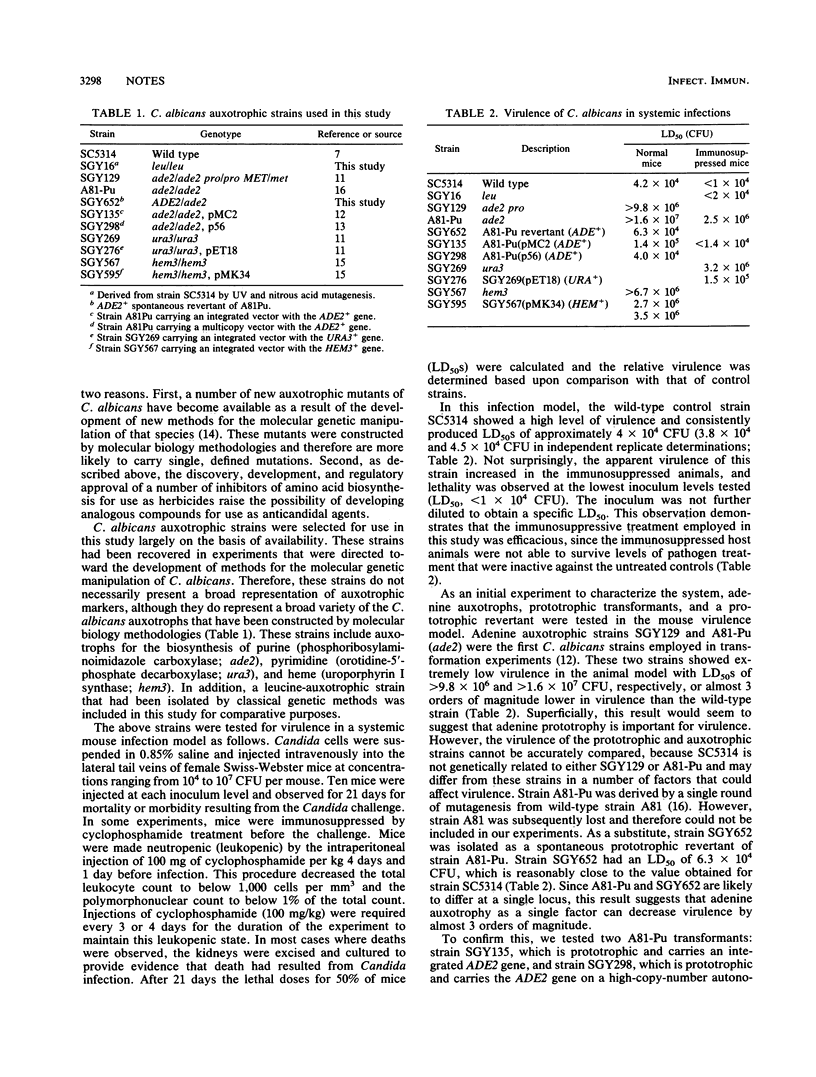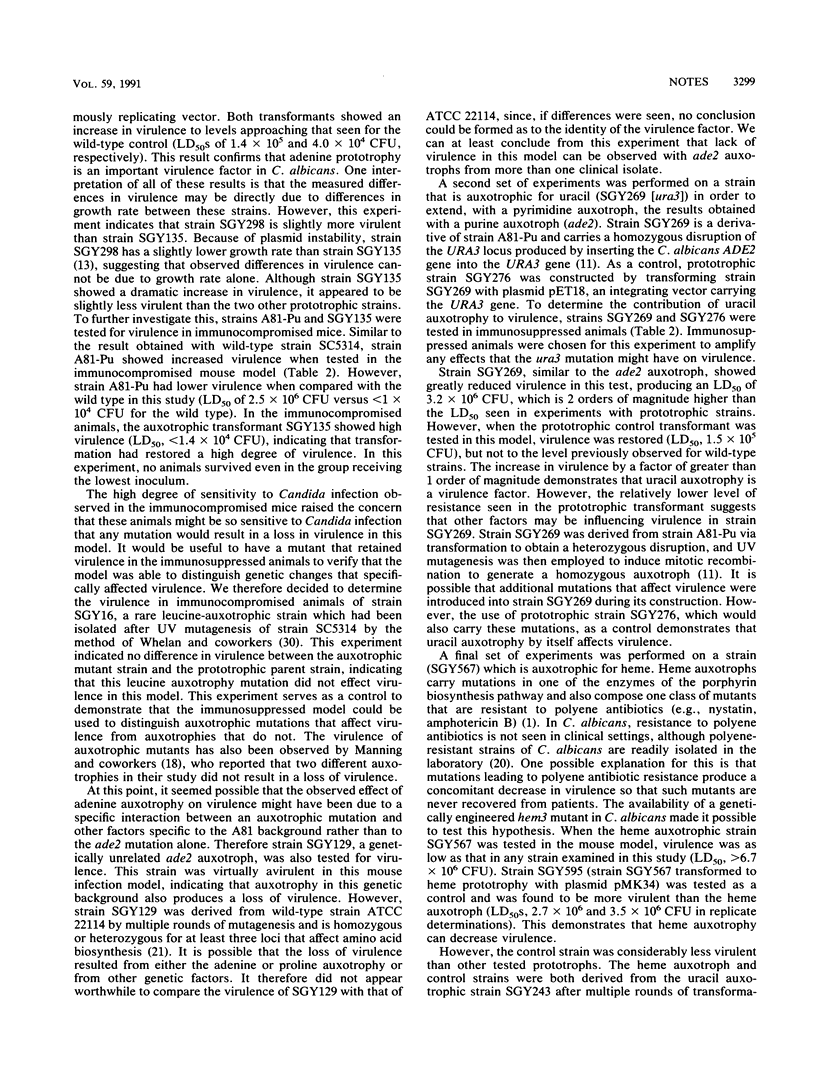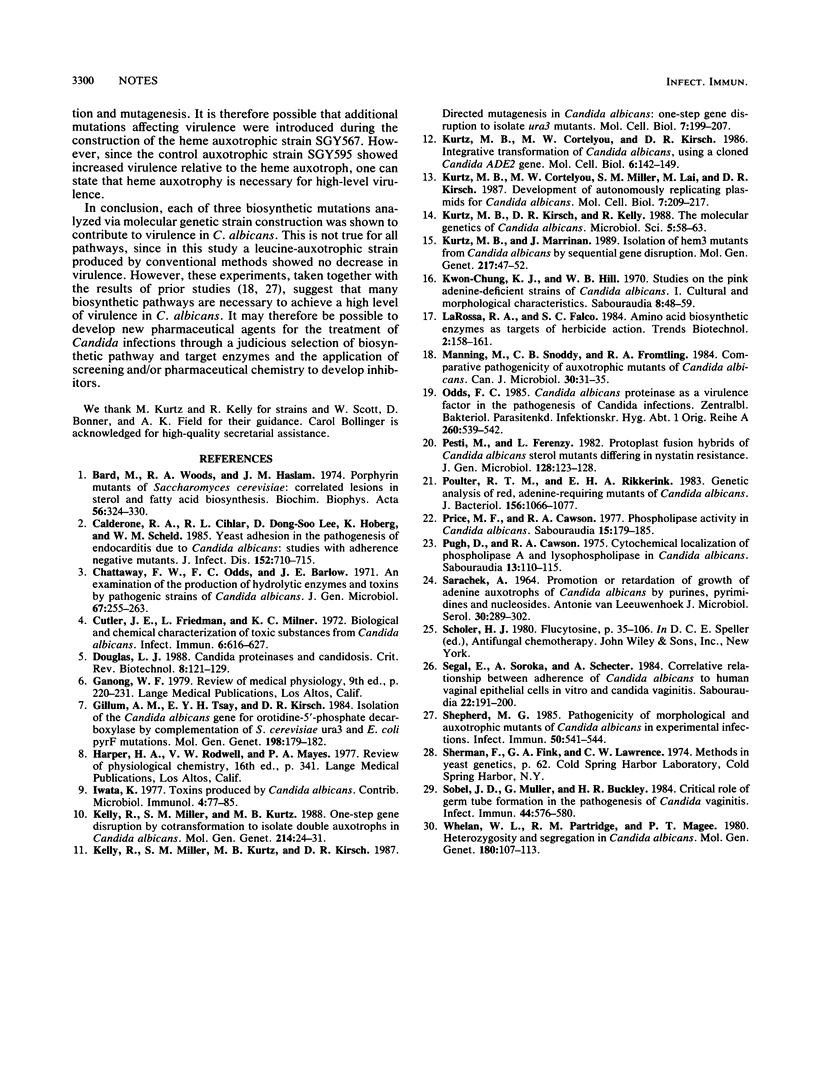Abstract
Auxotrophic and prototrophic control strain pairs of Candida albicans constructed by molecular biology methodologies were evaluated for pathogenicity in a systemic mouse model. Mutants that were auxotrophic for adenine, uracil, and heme each showed a lowered level of pathogenicity relative to control strains. It can be concluded from these experiments that decreased pathogenicity in each case is due to the auxotrophic mutation, because mutant and control strains were constructed so as to differ at a single locus. These observations suggest that new therapeutic agents for Candida infections might be designed based upon the inhibition of biosynthetic pathways that, in some cases, might be absent from the host.
Full text
PDF



Selected References
These references are in PubMed. This may not be the complete list of references from this article.
- Bard M., Woods R. A., Haslam J. M. Porphyrine mutants of Saccharomyces cerevisiae: correlated lesions in sterol and fatty acid biosynthesis. Biochem Biophys Res Commun. 1974 Jan 23;56(2):324–330. doi: 10.1016/0006-291x(74)90845-6. [DOI] [PubMed] [Google Scholar]
- Calderone R. A., Cihlar R. L., Lee D. D., Hoberg K., Scheld W. M. Yeast adhesion in the pathogenesis of endocarditis due to Candida albicans: studies with adherence-negative mutants. J Infect Dis. 1985 Oct;152(4):710–715. doi: 10.1093/infdis/152.4.710. [DOI] [PubMed] [Google Scholar]
- Chattaway F. W., Odds F. C., Barlow A. J. An examination of the production of hydrolytic enzymes and toxins by pathogenic strains of Candida albicans. J Gen Microbiol. 1971 Aug;67(3):255–263. doi: 10.1099/00221287-67-3-255. [DOI] [PubMed] [Google Scholar]
- Chung K. J., Hill W. B. Studies on the pink, adenine-deficient strains of Candida albicans. I. Cultural and morphological characteristics. Sabouraudia. 1970 May;8(1):48–59. [PubMed] [Google Scholar]
- Cutler J. E., Friedman L., Milner K. C. Biological and chemical characterization of toxic substances from Candida albicans. Infect Immun. 1972 Oct;6(4):616–627. doi: 10.1128/iai.6.4.616-627.1972. [DOI] [PMC free article] [PubMed] [Google Scholar]
- Douglas L. J. Candida proteinases and candidosis. Crit Rev Biotechnol. 1988;8(2):121–129. doi: 10.3109/07388558809150541. [DOI] [PubMed] [Google Scholar]
- Gillum A. M., Tsay E. Y., Kirsch D. R. Isolation of the Candida albicans gene for orotidine-5'-phosphate decarboxylase by complementation of S. cerevisiae ura3 and E. coli pyrF mutations. Mol Gen Genet. 1984;198(2):179–182. doi: 10.1007/BF00328721. [DOI] [PubMed] [Google Scholar]
- Iwata K. Toxins produced by Candida albicans. Contrib Microbiol Immunol. 1977;4:77–85. [PubMed] [Google Scholar]
- Kelly R., Miller S. M., Kurtz M. B., Kirsch D. R. Directed mutagenesis in Candida albicans: one-step gene disruption to isolate ura3 mutants. Mol Cell Biol. 1987 Jan;7(1):199–208. doi: 10.1128/mcb.7.1.199. [DOI] [PMC free article] [PubMed] [Google Scholar]
- Kelly R., Miller S. M., Kurtz M. B. One-step gene disruption by cotransformation to isolate double auxotrophs in Candida albicans. Mol Gen Genet. 1988 Sep;214(1):24–31. doi: 10.1007/BF00340174. [DOI] [PubMed] [Google Scholar]
- Kurtz M. B., Cortelyou M. W., Kirsch D. R. Integrative transformation of Candida albicans, using a cloned Candida ADE2 gene. Mol Cell Biol. 1986 Jan;6(1):142–149. doi: 10.1128/mcb.6.1.142. [DOI] [PMC free article] [PubMed] [Google Scholar]
- Kurtz M. B., Cortelyou M. W., Miller S. M., Lai M., Kirsch D. R. Development of autonomously replicating plasmids for Candida albicans. Mol Cell Biol. 1987 Jan;7(1):209–217. doi: 10.1128/mcb.7.1.209. [DOI] [PMC free article] [PubMed] [Google Scholar]
- Kurtz M. B., Kirsch D. R., Kelly R. The molecular genetics of Candida albicans. Microbiol Sci. 1988 Feb;5(2):58–63. [PubMed] [Google Scholar]
- Kurtz M. B., Marrinan J. Isolation of hem3 mutants from Candida albicans by sequential gene disruption. Mol Gen Genet. 1989 May;217(1):47–52. doi: 10.1007/BF00330941. [DOI] [PubMed] [Google Scholar]
- Manning M., Snoddy C. B., Fromtling R. A. Comparative pathogenicity of auxotrophic mutants of Candida albicans. Can J Microbiol. 1984 Jan;30(1):31–35. doi: 10.1139/m84-005. [DOI] [PubMed] [Google Scholar]
- Odds F. C. Candida albicans proteinase as a virulence factor in the pathogenesis of Candida infections. Zentralbl Bakteriol Mikrobiol Hyg A. 1985 Dec;260(4):539–542. doi: 10.1016/s0176-6724(85)80069-9. [DOI] [PubMed] [Google Scholar]
- Pesti M., Ferenczy L. Protoplast fusion hybrids of Candida albicans sterol mutants differing in nystatin resistance. J Gen Microbiol. 1982 Jan;128(1):123–128. doi: 10.1099/00221287-128-1-123. [DOI] [PubMed] [Google Scholar]
- Poulter R. T., Rikkerink E. H. Genetic analysis of red, adenine-requiring mutants of Candida albicans. J Bacteriol. 1983 Dec;156(3):1066–1077. doi: 10.1128/jb.156.3.1066-1077.1983. [DOI] [PMC free article] [PubMed] [Google Scholar]
- Price M. F., Cawson R. A. Phospholipase activity in Candida albicans. Sabouraudia. 1977 Jul;15(2):179–185. [PubMed] [Google Scholar]
- Pugh D., Cawson R. A. The cytochemical localization of phospholipase a and lysophospholipase in Candida albicans. Sabouraudia. 1975 Mar;13(Pt 1):110–115. doi: 10.1080/00362177585190181. [DOI] [PubMed] [Google Scholar]
- SARACHEK A. PROMOTION OF RETARDATION OF THE GROWTH OF ADENINE AUXOTROPHS OF CANDIDA ALBICANS BY PURINES, PYRIMIDINES AND NUCLEOSIDES. Antonie Van Leeuwenhoek. 1964;30:289–302. doi: 10.1007/BF02046735. [DOI] [PubMed] [Google Scholar]
- Segal E., Soroka A., Schechter A. Correlative relationship between adherence of Candida albicans to human vaginal epithelial cells in vitro and candidal vaginitis. Sabouraudia. 1984;22(3):191–200. [PubMed] [Google Scholar]
- Shepherd M. G. Pathogenicity of morphological and auxotrophic mutants of Candida albicans in experimental infections. Infect Immun. 1985 Nov;50(2):541–544. doi: 10.1128/iai.50.2.541-544.1985. [DOI] [PMC free article] [PubMed] [Google Scholar]
- Sobel J. D., Muller G., Buckley H. R. Critical role of germ tube formation in the pathogenesis of candidal vaginitis. Infect Immun. 1984 Jun;44(3):576–580. doi: 10.1128/iai.44.3.576-580.1984. [DOI] [PMC free article] [PubMed] [Google Scholar]
- Whelan W. L., Partridge R. M., Magee P. T. Heterozygosity and segregation in Candida albicans. Mol Gen Genet. 1980;180(1):107–113. doi: 10.1007/BF00267358. [DOI] [PubMed] [Google Scholar]


